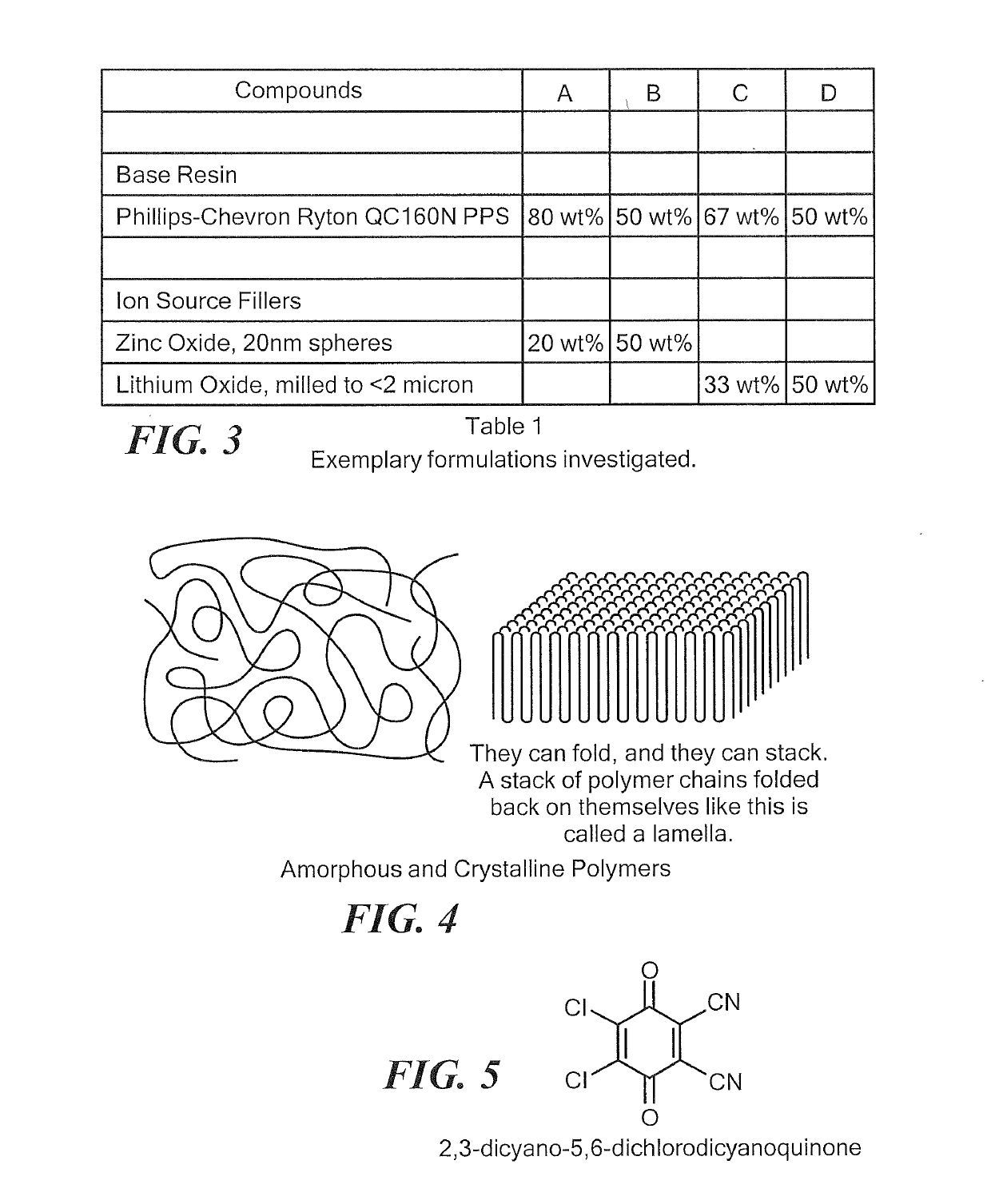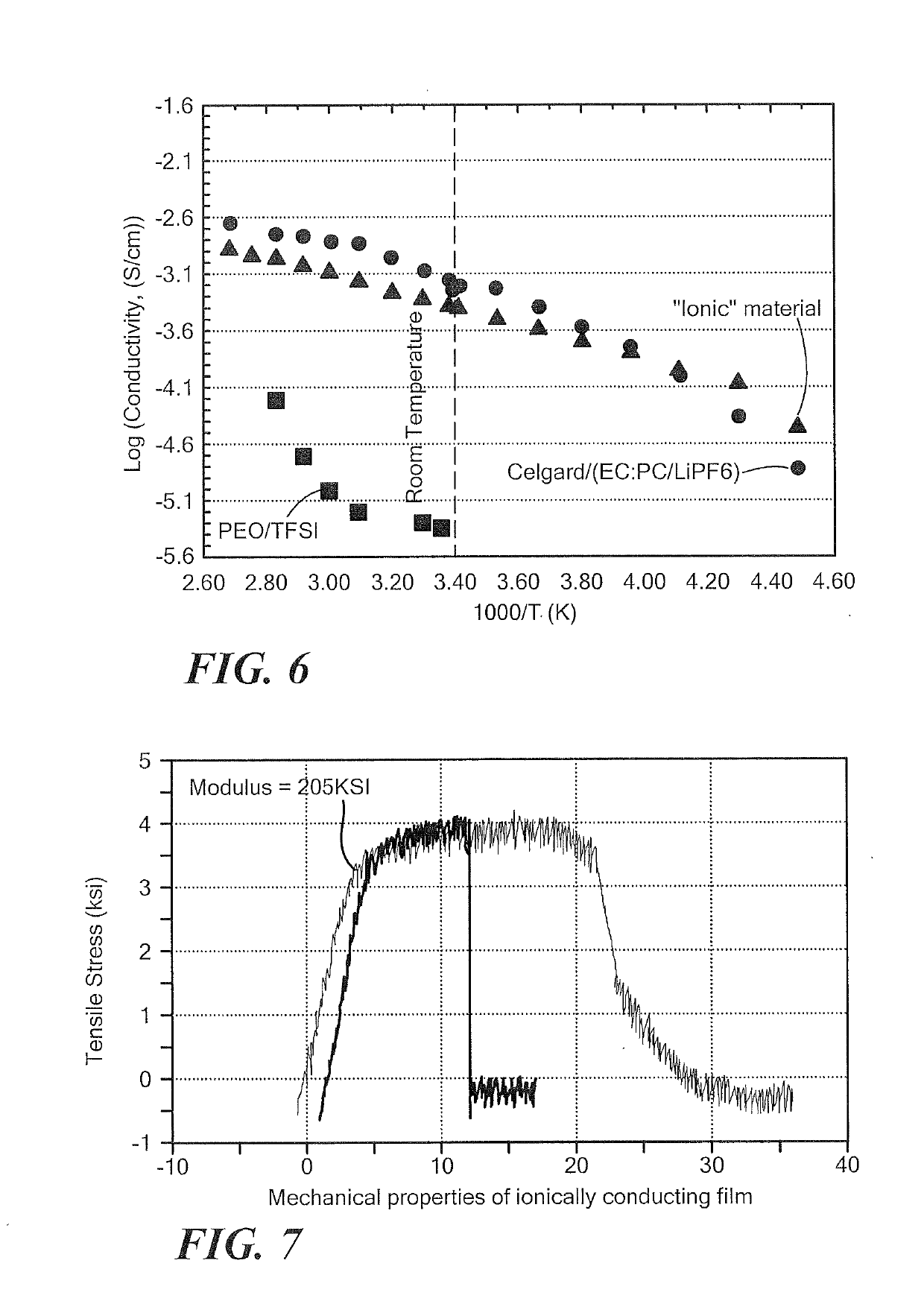High capacity polymer cathode and high energy density rechargeable cell comprising the cathode
a polymer cathode and high energy density technology, applied in cell components, electrochemical generators, electrolytic capacitors, etc., can solve the problems of limited number of recharges, slow charge times of conventional lithium ion batteries, and eventual failure of batteries, etc., to achieve high ionic diffusivity and conductivity
- Summary
- Abstract
- Description
- Claims
- Application Information
AI Technical Summary
Benefits of technology
Problems solved by technology
Method used
Image
Examples
example 1
[0084]Solid polymer electrolyte was made by mixing PPS base polymer and ion source compound LiOH monohydrate in the proportion of 67% to 33% (by wt.), respectively, and mixed using jet milling. DDQ dopant was added to the resulting mixture in the amount of 1 mole of DDQ per 4.2 moles of PPS. The mixture was heat treated at 325 / 250° C. for 30 minutes under moderate pressure (500-1000 PSI). After cooling, the resulting material was grinded and placed into NMR fixture.
[0085]Self-diffusion coefficients were determined by using pulsed field gradient solid state NMR technique. The results shown in FIG. 20 indicates, that Li+ diffusivity in the solid polymer electrolyte is the highest of any known solid, and over an order of magnitude higher at room temperature compared to recently developed Li10GeP2S12 ceramic at much higher temperatures (140° C.) or the best PEO formulation at 90° C.
example 2
[0086]PPS base polymer and ion source compound LiOH monohydrate were added together in the proportion of 67% to 33% (wt / wt), respectively, and were mixed using jet milling. DDQ dopant was added to the resulting mixture in the amount of 1 mole of DDQ per 4.2 moles of PPS. The mixture was compression molded at 325° C. / 250° C. for 30 minutes under low pressure. The polymer-sulfur composite cathode was prepared by additionally mixing from 25% to 50% of sulfur powder, 5% to 15% of C45 carbon black, and 0% to 10% LiNO3 with the solid, ionically conducting polymer material. The materials were compression molded onto stainless steel mesh (Dexmet) at 120° C. for 30 minutes, yielding a cathode disc 15 mm in diameter and 0.3 to 0.4 mm thick.
[0087]The resulting cathodes were used to assemble test cells in 2035 coin cell hardware. Polypropylene separator (Celgard) 25 microns thick and 19 mm in diameter was used along with lithium foil anode material, 15 mm in diameter. A liquid electrolyte of 1M...
example 3
[0090]Composite polymer-sulfur cathodes were manufactured as described in Example 16. These cathodes were assembled into coin cells using lithium metal anodes, polypropylene separator, and 1M LiTFSI in DOL / DME electrolyte with 0.5M LiNO3 additive.
[0091]Cells were discharged under constant current conditions (1 mA) using a Maccor 4600 battery test system. Discharge was terminated at a voltage of 1.75 V. Charge was accomplished in two steps, the first at a lower charge rate of 0.2 mA current to a maximum voltage of 2.3 V, and the second charge step at a higher rate of 1 mA current to a maximum voltage of 2.45 V. The overall charge capacity was limited for these test cells. These cells were allowed to cycle several times at room temperature.
[0092]FIG. 20 shows the discharge capacity curve plotted as a function of cycle number for Li / composite polymer-sulfur cell of the present invention. The capacity curve graph shows that the composite polymer-sulfur cathode will support reversible ch...
PUM
| Property | Measurement | Unit |
|---|---|---|
| ionic conductivity | aaaaa | aaaaa |
| crystallinity index | aaaaa | aaaaa |
| voltage | aaaaa | aaaaa |
Abstract
Description
Claims
Application Information
 Login to View More
Login to View More - R&D
- Intellectual Property
- Life Sciences
- Materials
- Tech Scout
- Unparalleled Data Quality
- Higher Quality Content
- 60% Fewer Hallucinations
Browse by: Latest US Patents, China's latest patents, Technical Efficacy Thesaurus, Application Domain, Technology Topic, Popular Technical Reports.
© 2025 PatSnap. All rights reserved.Legal|Privacy policy|Modern Slavery Act Transparency Statement|Sitemap|About US| Contact US: help@patsnap.com



